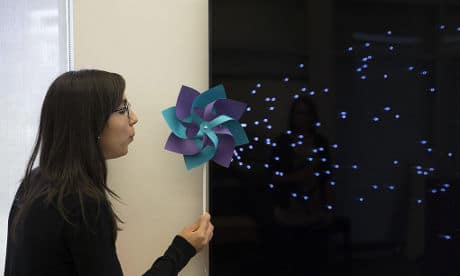
Researches from the University of Washington, Disney Research and Carnegie Mellon University have created a way to give a piece of paper sensing capabilities that enable it to respond to gesture commands and connect to the digital world using RFID tags that can be stuck, printed or drawn on the paper.
“The technology — PaperID — leverages inexpensive, off-the-shelf RFID tags which function without batteries but can be detected through a reader device placed in the same room as the tags,” the researchers say. “Each tag has a unique identification so a reader’s antenna can pick out an individual among many.
“These tags only cost about 10 cents each and can be stuck onto paper. Alternatively, the simple pattern of a tag’s antenna can also be drawn on paper with conductive ink.
“When a person’s hand waves, touches, swipes or covers a tag, the hand disturbs the signal path between an individual tag and its readers. Algorithms can recognise the specific movements, then classify a signal interruption as a specific command. For example, swiping a hand over a tag placed on a pop-up book might cause the book to play a specific, programmed sound.”
Interaction methods
“The researchers developed different interaction methods to adapt RFID tags depending on the type of interaction that the user wants to achieve,” the researchers add. “For example, a simple sticker tag works well for an on/off button command, while multiple tags drawn side-by-side on paper in an array or circle can serve as sliders and knobs.
“They also can track the velocity of objects in movement, such as following the motion of a tagged paper conductor’s wand and adjusting the pace of the music based on the tempo of the wand in mid-air.
“This technique can be used on other mediums besides paper to enable gesture-based sensing capabilities. The researchers chose to demonstrate on paper in part because it’s ubiquitous, flexible and recyclable, fitting the intended goal of creating simple, cost-effective interfaces that can be made quickly on demand for small tasks.”
A video gives an overview of PaperID:
“These little tags, by applying our signal processing and machine learning algorithms, can be turned into a multi-gesture sensor,” says Hanchuan Li, a University of Washington doctoral student in computer science and engineering.
“Our research is pushing the boundaries of using commodity hardware to do something it wasn’t able to do before.”
“Ultimately, these techniques can be extended beyond paper to a wide range of materials and usage scenarios,” adds Alanson Sample, research scientist at Disney Research. “What’s exciting is that PaperID provides a new way to link the real and virtual worlds through low cost and ubiquitous gesture interfaces.”
Next: Visit the NFCW Expo to find new suppliers and solutions